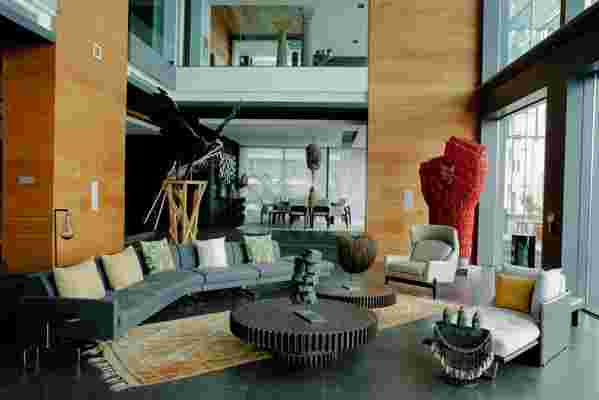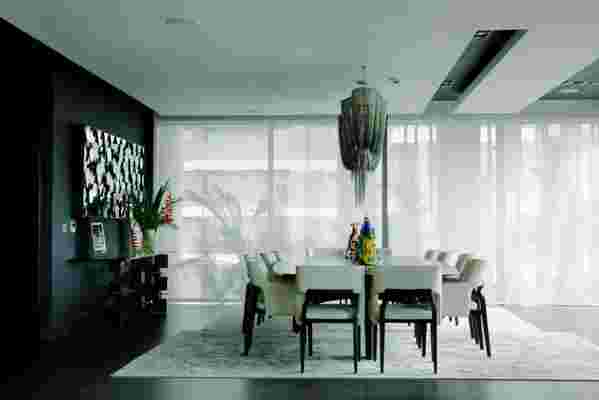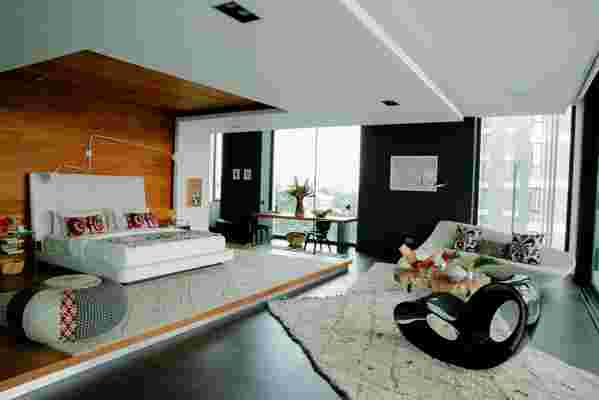Reni Folawiyo had one goal in mind when she opened her renowned luxury concept store, Alára, in Lagos, Nigeria, six years ago. “ Alára is a Yoruba word that means ‘wondrous performer, somebody who thrills endlessly,’ ” Folawiyo, an attorney turned lifestyle entrepreneur, explains, “and we wanted to thrill.” Designed by celebrated Ghanaian-British AD100 architect, Sir David Adjaye, the three-story temple to style not only delights, it offers a painstakingly curated mix of fashion, art, and design. Home to both African and Western brands, it’s a place where Jacquemus trousers and Saint Laurent slingbacks mingle effortlessly with Hassan Hajjaj photographs, woven baskets from Burkina Faso, and designer Kenneth Ize’s signature aso oke suits.
It’s little wonder that in its relatively short existence, Alára has earned comparisons to Milan’s 10 Corso Como and London’s Dover Street Market. And as a beacon of bold modernist architecture, its iconic red-sand exterior, inspired by the deserts of North Africa, has become a go-to backdrop for homegrown Instagram-obsessed influencers. “Reni wanted to create something in Africa that would really be a lightning rod about the potential of the continent to produce design excellence,” Adjaye says of Folawiyo, whom he calls a creative force and a kindred spirit. Mission accomplished.

Two sculptures, an eagle by Wim Botha and a colossal red piece by Dominique Zinkpè, dominate one end of the living room. Jérôme Abel Seguin cocktail tables.
A short drive from Alára, in Lagos’s tony Ikoyi enclave, is another of Folawiyo’s spectacular creations: her family home. Nestled on a quiet side street, far away from the din of honking horns and boisterous street vendors hawking everything from charred plantains to terra-cotta planters, Folawiyo’s sprawling penthouse duplex perches atop an 11-unit boutique apartment complex she and her husband, Tunde, erected. Folawiyo, who calls herself an “unapologetic proponent of the brilliance of Africa and its contemporary language,” chose award-winning Cape Town–based architecture firm SAOTA for this undertaking. She tasked the firm with creating a modern, wide-open expanse with remarkable scale that seamlessly merged indoor and outdoor living. During the three-year build, she pushed architect Stefan Antoni to amp up the wow factor, telling him, “We want more drama! After that, he just went to town.”
Folawiyo’s four-bedroom, nearly 14,000-square-foot residence boasts soaring floor-to-ceiling windows, breathtaking views of surrounding treetops, and an epic terrace (complete with infinity pool) that has achieved near-mythical status in the megacity. “I love to throw parties here,” Folawiyo, a mother of two, says as she strolls alongside the pool’s azure waters. Her daughter, Faridah, an art curator, does as well. “My husband is much quieter than me,” Folawiyo adds. “He always hides in the corner.”

A Terzani chandelier hangs above a custom dining table and chairs by Caste Design.
Brimming with sculpture, furniture, and art that Folawiyo has amassed during her more than three decades of world travel, the sun-suffused space is a reflection of her passions and experiences. “Every piece is important to me and has a very meaningful story,” she says, offering a tour. The 1990s-era El Anatsui carvings hail from Ghana, and the beaded traditional headdresses in her dining room come from Ogbomosho, in southwest Nigeria. Originally a single cabinet, the white side tables in her daughter’s vibrant bedroom were discovered at Rossana Orlandi’s famed Milan gallery. Other design trophies include a sinuous walnut bench by South Korean artist Bae Se Hwa and a lacquer Ron Arad rocking chair. Vintage Moroccan rugs collected over years serve as warm accents throughout. In the vast living room, soft throw cushions from Senegalese textile designer Aïssa Dione, a dear friend, rest near Goyard pillows on custom Poltrona Frau couches. Gently petting a Nacho Carbonell bush statue, she says, “I love that this feels like hair.”
Jérôme Abel Seguin’s industrial coffee tables from Indonesia were so heavy that they had to be brought in by crane. “I knew that Jérôme’s pieces would help form the core of my home,” Folawiyo says. “I’ve been dreaming of collecting his work for years.” Seguin has said that he “creates objects that cry out to be caressed.” So, naturally, one can’t help but stroke the mahogany-root console standing in a nook.
Fashioned from a single slab of wood, the colossal, tomato-red Dominique Zinkpè sculpture is an awe-inspiring marvel composed of hundreds of carved miniature figures. “The size, the layers of wood, the details, it’s tremendous,” Folawiyo says. A headless eagle by South African artist Wim Botha has proved a reliable conversation starter. “People are shocked by this piece. They don’t really understand it. ‘What is this? Why do you have it in your home? What about this do you like?’ ” She bursts into laughter. “A lot of people are confused by it, but art is like that.”

Making her way to the second floor, Folawiyo points out that all of the timber featured in her home was locally sourced and produced in the factory she opened to meet the demands of her burgeoning furniture line. In a town where gilded fixtures and gleaming marble reign among the haute société, her gray slate floors are an anomaly. “I didn’t want a very flashy, over-finished space,” she says. “I wanted something more understated. This feels more natural and real to me.”
Folawiyo worked closely with Adam Court, creative director of interiors firm OKHA and then–lead designer for design studio ARRCC, to weave together the disparate design elements. “The architecture is very lean and taut, whereas the interior is a lot more loose and has a sort of casualness to it,” he explains. “It all works together because it’s done with ease and fluency and confidence. It’s not an artificial composition of things that have been put together by an interior designer. It’s a very honest reflection of Reni.”
